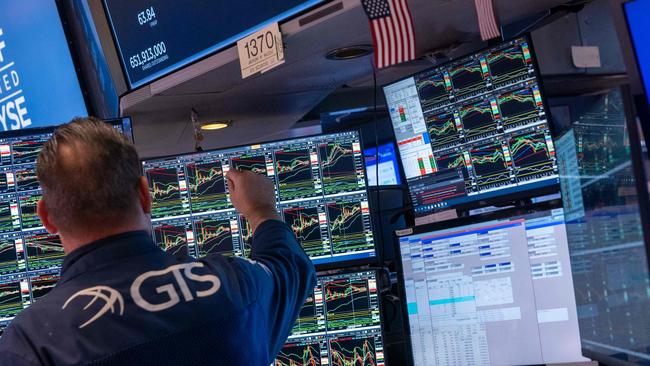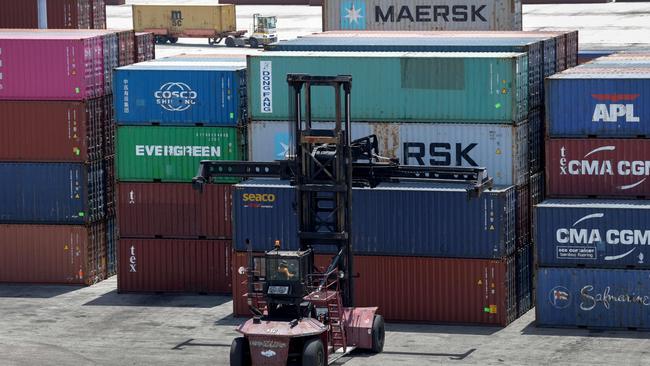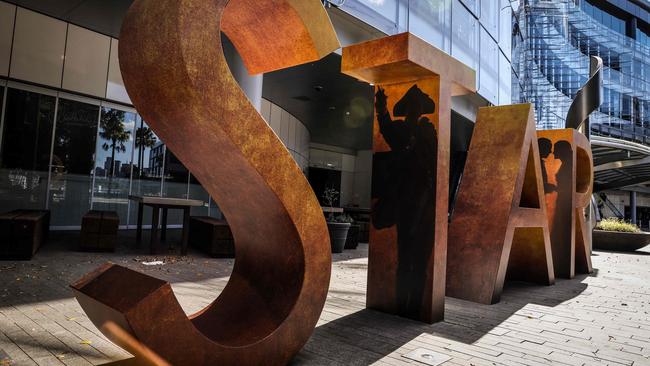
Washington is scheduled to sell $US180bn of bonds in coming days to help plug its yawning trillion-dollar budget deficits.
For context, this three-day borrowing spree eclipses Australia’s entire funding requirement forecast for next year of $150bn, or $US90bn.
The biggest buyers of these bonds have consistently been China and Japan, helping to keep interest rates down for both short and long-term borrowing.
It happens that China is now effectively locked in an unpredictable and open economic war with Donald Trump, and has threatened to “fight to the end” on escalating tariffs. Japan is simply furious about the attempted crushing of its auto industry and its economy.
When the drama of equity markets grab all the attention the real action always takes place in credit markets, and any hint of disorder in the US Treasury’s fundraising efforts will be critical to measuring whether markets have hit a dangerous milestone.
Debt is the oxygen that keeps banks, governments and many corporates alive, and the global financial crisis became destructive the moment that credit markets seized up.
Five years ago, early in the Covid-19 pandemic, credit markets also began shutting down. This prompted central banks to react quickly to pump in hundreds of billions of liquidity to get debt moving normally again.

Remember, the starting point for bond investors is whether they will get their money back. Whereas share investors begin the conversation with “how much upside is there for me?”.
Following Wall Street’s two-day Trump Dump and Monday’s extraordinary volatility, Australia became one of the first countries to test the health of money markets. Thankfully it passed.
Canberra’s financing arm made a tentative issue of just $400m worth of 10-year bonds, a mere drop in a massive credit market ocean.
Backed by Australia’s AAA rating, the issue represented the lowest risk asset up for grabs in the world on Tuesday. Adding to the appeal, it was packaged as a “green bond” – still in high demand among European investors.
The result? The Australian Office of Financial Management was bowled over with demand, the issue was almost five times oversubscribed and pricing came in at the very bottom end of a tight range (4.17 per cent) and a hefty discount to the advertised rate of 4.25 per cent.
That’s good for Australian taxpayers, and shows there’s still appetite for credit investors to invest, but their risk appetite is close to zero. Buyers are out there but they are looking for a safe harbour.
The issue was closely watched by markets to see if the turmoil on equities had jumped to the credit markets.
“Overwhelmingly, bond investors are very constructive on Australia, says NSW TCorp general manager of financial markets Rob Kenna, who oversees a $190bn-plus bond book on behalf of the NSW government and several of the state’s authorities.
“Australia still looks like a very, very safe and stable environment with pretty conservative fiscal and debt settings that are appealing to investors. We’re seeing a lot of those global investors putting money into state government bonds, but also federal government bonds as well.”
While activity in terms of issuance of new paper has understandably slowed sharply, there “aren’t any concerns about the fundamentals in the market”, Kenna tells The Australian. For the main, investors are taking a cautious approach until the landscape is clearer.
Where there is uncertainty it is around what is the right price to take on the risking risk of a US recession and China’s growth coming in slower-than-expected and taking the rest of the global economy down with it.
This shows the danger inherent in Trump’s tariff strategy even if it is all a negotiating bluff. Not only is he putting up trade walls that fire inflation, but he also risks starving the US economy of the trillions in funds it needs to grow.
Star’s busy boardroom
From today Bally’s chair Soo Kim and Australia’s Bruce Mathieson Jnr will sit in on all of Star Entertainment’s board meetings – although they are technically invitees not observers – giving the pair unprecedented access to the struggling casino as it prepares to sign off its long-delayed accounts.
Star will get the first $100m of its $300m bailout on Thursday morning, heading off what would have been certain collapse of the casino operator following the failure of last week’s $750m Salters Brothers financing deal. The complex funding transaction came together in just days.
The Australian revealed Star’s board last week had been working on two administration scenarios in parallel to the Bally’s rescue.
Star shareholders will be asked to approve the $300m financing deal, which delivers both Bally’s Kim and Mathieson a more than 56 per cent stake in the casino.
It wasn’t a great deal, but it was the only deal Star had. It represents the best deal for a chance to survive.
The convertible note, an instrument used widely by companies looking to raise cash quickly during the Covid-19 pandemic, implies Star’s existing shares are worth close to zero.
The convertible structure, is considered equity, not debt, and allows the issuer to secure a lower interest rate compared to a subordinated debt facility.

However, the cost is a premium to the nominal share price. Star has placed a value of 8c on the conversion.
Star went into a trading halt at the end of February, with its shares last changing hands at 11c.
The transaction also leaves Star’s directors wide open to the risk of collapse, given there has been no effective due diligence by Bally’s.
Nor is there certainty on the Star side that Bally’s has the capacity for the multiple cash injections needed at Star.
Back home, Bally’s new Chicago casino is ramping up slower than expected and still faces financing costs of building the new permanent casino and hotel at the former Chicago Tribune printing site.
Bally’s told investors overnight it has available funds to support the transaction. Mathieson will fund a third of the deal.
The Bally’s rescue plan assumes a separate transaction that Star outlined early last month moves ahead, involving the exit from the new Queen’s Wharf, selling the casino there and other properties to its Hong Kong partners in exchange for a nominal $53m and full control of two hotels. That was struck without diligence, meaning there could be additional costs.
Following a shareholder vote on the convertible note deal, two former veterans of Mathieson’s pub group Australian Liquor and Hospitality – David Curry and Con Nikitas – will take yet-to-be-defined management roles at Star.
The $300m delivers Star a short-term fix, however it doesn’t solve the myriad of structural problems.
Star is believed to be burning through $25m cash a month. There’s still outstanding potential fine with financial regulator Austrac. There’s also the underpayment of casino duty in NSW and interest on the outstanding $430m lending facility and other litigation costs to come.
That has all been kicked down the road. Star directors led by former NAB legal boss Anne Ward will now turn their attention to signing-off on Star’s accounts, which will show just how close the casino came to collapse. The next step will be the June shareholder vote on the debt-for-equity plan.
eric.johnston@news.com.au




A sharemarket rebound has offered some respite but the next test for markets is lurking in another corner.